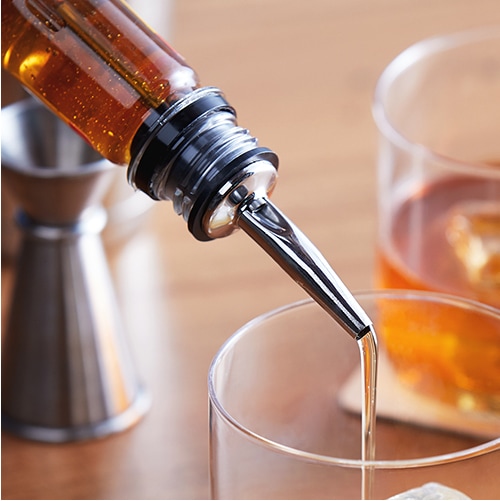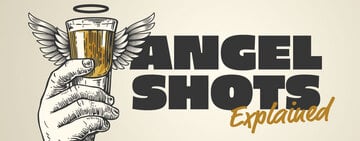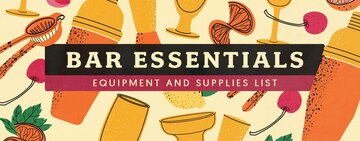If you’re an aspiring bartender, you must learn how to pour an accurate amount of liquor fast. From measuring liquor in a jigger to using measured pourers, there are multiple methods bartenders can use to serve precise amounts of alcohol for shots and cocktails. To keep up in busy nightlife environments, use our guide to the different ways to measure liquor, and learn how to apply each method with our liquor pouring video tutorial.
Shop All Liquor PourersHow Do Bartenders Measure Liquor
There are several tools and methods you can use to measure liquor. Discover the different ways you can measure liquor, along with each strategy's pros and cons, below:
1. Jiggers
A jigger is a measurement tool that helps bartenders obtain equal shots of liquor for their drinks. The pros and cons of measuring liquor with a jigger are as follows:
- Ensures consistency - Your drinks will come out the same every time.
- Cuts costs - By guaranteeing how much liquor is going into each drink, jiggers can reduce revenue loss.
2. Free Pouring
Free pouring is the art of pouring liquor and counting down to gauge the correct amount. The pros and cons of free pouring are as follows:
- Saves time - It is much faster to free pour liquor than to measure it in a jigger. The ability to serve more drinks may increase your bar’s profit margins and the number of tips you’ll earn.
- Multi-tasking - Because free pouring only requires one hand, you can use your free hand to prepare other drinks.
- Visually enticing - Free pouring adds an element of showmanship to the drink-making process.

3. Measured Pourers
Measured liquor pourers are designed to accurately dispense certain pour increments, making it easy for bartenders to quickly serve precise amounts of liquor. The pros and cons of measuring liquor with a measured pourer are as follows.
- Liquor inventory management - Controls how much liquor goes into each drink and prevents heavy-handed liquor pours.
- Flavor control - Ensures your cocktails offer the same delicious flavor every time they’re ordered.
4. Precision Pour Bottle Rack Systems
Precision pour bottle rack systems provide quick, accurate results for measuring liquor. You install your liquor bottle to the pourer head, and then mount the entire unit upside down. This allows your liquor to flow freely when you dispense it by pressing the rim of your glass against the bottom of the head. Like measured pourers, precision pour rack systems dispense preset amounts of liquor. The pros and cons of measuring liquor with precision pour rack systems are as follows:
- Accurate - Ensures the right amount of liquor is dispensed every time.
- Fast - Eliminates the extra step of measuring liquor.
- Multi-Bottle Units Available - Many precision pour bottle rack systems allow you to load multiple liquor bottles into the same unit for convenience.

Liquor Pouring FAQ
Get answers to the most common questions about pouring liquor below.
What Is the Standard Pour in a Single Mixer Cocktail?
The standard pour for single mixer cocktails is 1 1/2 fl. oz. of liquor.
How Many Counts Is a Shot?
A 3-count liquor pour equals one shot. Each count delivers 1/2 a fl. oz., so it takes 3 counts to create the standard 1 1/2 fl. oz. shot.
How Many Counts for Neat/on the Rocks Drinks?
A 4-count pour is standard for liquor served neat/on the rocks with no mixers. You’ll want to give patrons who order a fine whiskey a generous 2 fl. oz. pour.
How Many Tablespoons in a Shot?
There are three tablespoons in a shot.
How Many Teaspoons Are in a Shot Glass?
There are nine teaspoons in a shot.
How Many Shots in a Cup?
There are 8 shots in a cup. 8 fl. oz. is a standard volume cup, and a standard shot varies between 1 and 1 1/2 fl. oz.
How Many Seconds Is a 2 Oz. Pour?
It takes 4 seconds to pour 2 fl. oz. of alcohol. You can gauge seconds passing by counting them out.
How Many Seconds Is a 1 Oz. Pour?
It takes 2 seconds to pour 1 fl. oz. of liquor.
How Many Shots in a Liquor Bottle?
There are approximately 16 shots in a botte of liquor.
Back to Top
How to Free Pour Liquor
To free pour, bartenders top liquor bottles with speed pourers. Also known as pour spouts, speed pourers regulate how much air goes into the bottle they’re placed into which facilitates a steady stream of liquor. With a speed pourer on hand, use the following steps to free pour liquor:
- Place the speed pourer on the bottle. Consider which hand you’ll be pouring with and face the speed pourer’s spout towards the cup.
- Hold the liquor bottle by its neck. This provides greater control over the bottle. It also prevents heat transfer from your hand to the alcohol.
- Turn the bottle upside down. Keeping the bottle straight and holding it upside down ensures an even stream of liquor, so you can keep an accurate count while you pour.
- Count out your pour. Each count should equal 1/2 a fl. oz. of liquor. Count each pour with “one one-thousand".
- Cut the liquor. Flip your wrist to turn the liquor bottle right side up and stop the liquor from pouring. If you gradually turn the bottle, liquor will continue to pour after you’ve stopped counting.
- An alternate way to cut liquor: Once you’re ready to stop the liquor flow, jerk the bottle to cut it off before turning. This method increases speed so you can pour more drinks.
How to Free Pour without a Stopper
While many newly hired bartenders wish they could free pour without a stopper/speed pourer, it is impossible to dispense accurate amounts of alcohol without a pourer spout. You must purchase a speed pourer if you want to count liquor measurements without a jigger.
How to Count Liquor

To get comfortable counting liquor, practice free pouring into a jigger and counting while you do it. This will give you confidence in how quickly you should be counting. The classic “one one-thousand" is a good way to count liquor, but you must practice your pacing to perfect your free pour.
Once you feel confident in your counting cadence, follow these steps to practice counting liquor:
- Free pour four counts of liquor into your cup, and then cut the liquor.
- Test your accuracy by pouring the cup’s contents into your jigger.
- If it reaches the 2 fl. oz. line on the jigger, congratulations, you have mastered free pouring.
How to Count Ounces When Pouring
The best way to count fl. oz.'s when pouring alcohol is to say “one one-thousand" for each pour count. Your cadence should allow for a 1/2 fl. oz. of liquor to dispense per each "one one-thousand". Perfecting how fast you count requires practice.
Pour Counts for Bartending
When calculating pour counts for bartending, keep in mind that each count should equal 1/2 a fl. oz. of liquor. We provide a cheat sheet that breaks down how high you should count to pour popular quantities of liquor below.
- 1 count pour = 1/2 fl. oz.
- 2 count pour = 1 fl. oz.
- 3 count pour = 1 1/2 fl. oz.
- 4 count pour = 2 fl. oz.
- 5 count pour = 2 1/2 fl. oz.
- 6 count pour = 3 fl. oz.
- 7 count pour = 3 1/2 fl. oz.
- 8 count pour = 4 fl. oz.
If you're deciding between getting experience or going to bartender school, practicing measuring and pouring liquor will help prepare you for either environment. Reference back to our liquor pouring guide the next time you want to create the perfect distilled drink.



